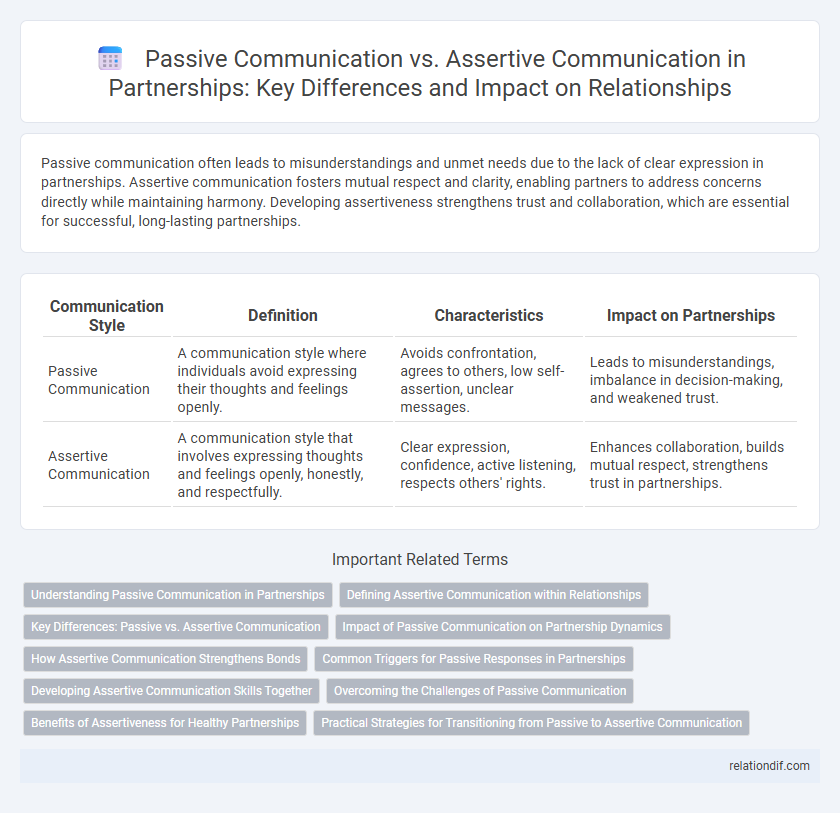Passive communication often leads to misunderstandings and unmet needs due to the lack of clear expression in partnerships. Assertive communication fosters mutual respect and clarity, enabling partners to address concerns directly while maintaining harmony. Developing assertiveness strengthens trust and collaboration, which are essential for successful, long-lasting partnerships.
Table of Comparison
| Communication Style | Definition | Characteristics | Impact on Partnerships |
|---|---|---|---|
| Passive Communication | A communication style where individuals avoid expressing their thoughts and feelings openly. | Avoids confrontation, agrees to others, low self-assertion, unclear messages. | Leads to misunderstandings, imbalance in decision-making, and weakened trust. |
| Assertive Communication | A communication style that involves expressing thoughts and feelings openly, honestly, and respectfully. | Clear expression, confidence, active listening, respects others' rights. | Enhances collaboration, builds mutual respect, strengthens trust in partnerships. |
Understanding Passive Communication in Partnerships
Passive communication in partnerships often leads to unmet needs and unresolved conflicts, weakening the relationship's foundation. Recognizing signs such as avoidance of expressing opinions or reluctance to set boundaries is key to identifying passive communication patterns. Addressing these behaviors fosters clearer dialogue, ensuring both partners feel heard and respected.
Defining Assertive Communication within Relationships
Assertive communication in partnerships involves expressing thoughts and feelings openly while respecting the partner's perspective, promoting mutual understanding and trust. Unlike passive communication, which often leads to misunderstandings and resentment, assertive communication fosters clear boundaries and healthier conflict resolution. Emphasizing honesty and active listening, assertive communication strengthens emotional connection and partnership resilience.
Key Differences: Passive vs. Assertive Communication
Passive communication often leads to misunderstandings and unexpressed needs, as individuals avoid expressing their opinions or feelings to keep the peace. Assertive communication emphasizes clear, respectful, and direct expression of thoughts and boundaries, fostering mutual respect and effective conflict resolution in partnerships. Understanding these key differences enhances collaboration and trust between partners, ensuring balanced and open dialogue.
Impact of Passive Communication on Partnership Dynamics
Passive communication in partnerships often leads to unexpressed needs and simmering resentments, which can erode trust and mutual respect over time. When partners refrain from assertively sharing thoughts or concerns, misunderstandings and imbalances in decision-making frequently arise, weakening the foundation of collaboration. This communication style reduces overall efficacy and satisfaction within the partnership by limiting open dialogue and stalling problem resolution.
How Assertive Communication Strengthens Bonds
Assertive communication strengthens bonds by promoting clear, honest exchanges that respect both parties' needs and boundaries, fostering mutual trust and understanding. This communication style reduces misunderstandings and resentment often caused by passive communication, enabling partners to address issues directly and effectively. Consistent assertiveness encourages a balanced partnership where open dialogue enhances emotional intimacy and cooperation.
Common Triggers for Passive Responses in Partnerships
Common triggers for passive responses in partnerships include fear of conflict, low self-esteem, and the desire to maintain harmony at all costs. Individuals may avoid expressing their true feelings to prevent misunderstandings or rejection, leading to unresolved issues. Recognizing these triggers is essential to foster assertive communication and build stronger, more transparent partnerships.
Developing Assertive Communication Skills Together
Developing assertive communication skills together enhances partnership by fostering mutual respect and clear expression of needs, reducing misunderstandings common in passive communication. Both partners learn to articulate their thoughts confidently while listening actively, creating a balanced dialogue that supports collaborative problem-solving and emotional honesty. This shared commitment to assertiveness strengthens trust and deepens connection, making the partnership more resilient and effective.
Overcoming the Challenges of Passive Communication
Overcoming the challenges of passive communication in partnerships requires recognizing its tendency to hinder clear expression of needs and boundaries, which can lead to misunderstandings and resentment. Developing assertive communication skills promotes transparency, mutual respect, and effective conflict resolution by encouraging partners to express thoughts and feelings openly while respecting others. Consistent practice of assertive techniques fosters healthier collaboration, enhances trust, and prevents the escalation of passive-aggressive behaviors within the partnership.
Benefits of Assertiveness for Healthy Partnerships
Assertive communication fosters trust and clarity in partnerships by allowing individuals to express their needs and boundaries confidently without aggression. This communication style promotes mutual respect, reduces misunderstandings, and enhances problem-solving, leading to healthier, more balanced relationships. Partners who practice assertiveness experience increased collaboration and emotional safety, strengthening the partnership's overall stability and success.
Practical Strategies for Transitioning from Passive to Assertive Communication
Implementing practical strategies such as setting clear personal boundaries and using "I" statements enhances assertive communication in partnerships by replacing passive tendencies. Regularly practicing active listening and maintaining consistent eye contact encourages mutual respect and fosters transparent dialogue. Role-playing difficult conversations and seeking feedback refine communication skills, facilitating a confident transition from passive to assertive interactions.
passive communication vs assertive communication Infographic

 relationdif.com
relationdif.com